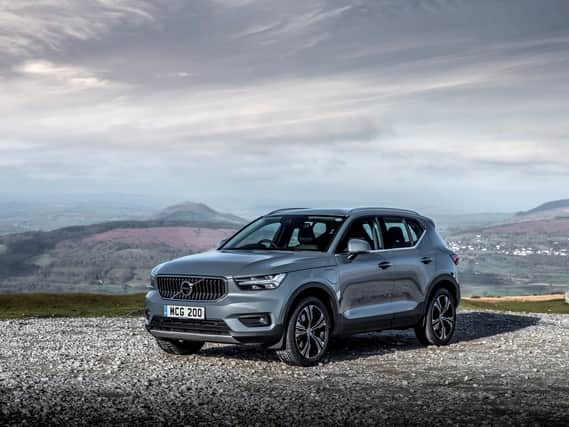Volvo XC40 Recharge review - classy SUV continues the charge towards electrification


Volvo has said that by 2025 it wants half of its new car sales to be fully electric vehicles. It’s a bold ambition, especially for a brand with just one pure EV ready to hit the market.
However, alongside the all-electric options, the Swedish brand expects the other half of its new sales to be “electrified” models - those with some form of hybrid drivetrain. Towards that goal, since late 2019 every car in the Volvo range has been available with either a mild or hybrid drivetrain.
Advertisement
Hide AdAdvertisement
Hide AdWhile the mild hybrids are a small part of the plan, front and centre of Volvo’s electrification dreams is the Recharge range of plug-in hybrids with their larger batteries, motors and all-electric ranges. Everything from the flagship XC90 down to the compact XC40 comes with a petrol-electric plug-in option, with varying battery and motor combinations.
The XC40 is already one of my favourite compact SUVs and the XC90’s T8 hybrid arrangement impressed me earlier in the year so, on paper, the XC40 Recharge PHEV should be a match made in heaven.


Like all current Volvos, the XC40 is built on a platform designed from the outset to accept hybrid and full-electric drivetrains, so there are no compromises inside or out to accommodate the PHEV drivetrain. The only visual differences between this, the petrol version and the all-electric model are a charging port in the front wing and a regular grille rather than the EV’s closed-off front.
That means, like every XC40, this twin engine model is squat, square and sharp looking. Parked next to my neighbour’s brand-new Evoque the bold Volvo makes the Range Rover look bland.
Advertisement
Hide AdAdvertisement
Hide AdThe interior lacks the Evoque’s overall opulence and there’s not huge space in the rear seats but there’s a pleasing simplicity to the Volvo’s clean interior design and the seating and driving position offer fantastic comfort whether you’re nipping to the shops or travelling the length of the country.
The XC40’s T5 drivetrain is based around a 1.5-litre, three-cylinder petrol engine with 176bhp. Supplementing that is an 81bhp electric motor for a total output of 257bhp, all of which is sent to the front wheels.
Volvo XC40 Recharge T5 Twin Engine Inscription Pro
- Price: £42,305 (£47,005 as tested)
- Engine: 1.5-litre, three-cylinder, turbo, petrol with 60kW electric motor
- Power: 257bhp
- Torque: n/a
- Transmission: Seven-speed automatic
- Top speed: 127mph
- 0-62mph: 7.3 seconds
- Economy: 119-139.4mpg
- CO2 emissions: 47-55g/km
That means that if you’re in a hurry the XC40 will hit 62mph in 7.3 seconds and can push on all the way to 127mph. However, behaving like that won’t make the most of the 10.7kWh battery and the clever hybrid drive options.
Official figures put the XC40 T5’s all-electric range at 28 miles but in the real-world our test car’s computer estimated a maximum of 24 miles on a full charge. For once, though, that proved to be pretty much spot-on. A series of runs designed to test the EV range and overall economy showed that with only the slightest change to my driving style I could complete a 24.1-mile round trip to the “big” supermarket entirely under battery power. You don’t even have to be that gentle with the throttle thanks to the Volvo’s ability to do up to 78mph in EV mode and a clear indicator showing when you’ll prompt the petrol engine to kick in.
Advertisement
Hide AdAdvertisement
Hide AdFor comparison, I did the same journey with the battery range showing 1 mile and achieved 43.2mpg. On a quick 124-mile cross-country run which started with a half charge and saw it topped up to 50 per cent again midway, I saw 51.7mpg.
Whatever state the battery is in, the whole experience is easy and refined, with a smooth transition between modes. And thanks to the battery hold function you can prime the car to reserve enough energy to do the school run or last urban leg of your commute in zero-emission mode.


The on-road feel of the XC40 is definitely firmer and more focused than something like an Evoque or a Lexus NX which means you can hustle along an A-road. But despite its decent turn of pace it’s still not a “sports” SUV in the way something like a Cupra Ateca is. It’s more about making decent progress in comfort and refinement, bolstered by some impressive in-gear acceleration for overtaking.
The XC40 range starts at around £25,000 but once you venture into the world of PHEVs things become a lot more expensive. Our top-of-the-range Inscription Pro weighed in at £42,000 before options but sadly things like a powered tailgate, smartphone integration, wireless charging and the panoramic sunroof added a further £4,700. To put that into context, however, an equivalent Range Rover Evoque PHEV will cost between £48,000 and £51,000, and the less desirable Vauxhall Grandland X Ultimate is a shade under £48,000, although both those are four-wheel-drive.
Advertisement
Hide AdAdvertisement
Hide AdSo it’s not cheap but even considering that, I walked away from the XC40 sure that it is one of my favourite cars of the year so far.
As with every PHEV, what you get out of it will depend on how you intend to use it. If you buy it as a tax dodge and never charge it then you’re dragging around that battery for nothing and can expect low-40s economy. Charge it regularly for lots of short runs and you’ll see significant benefits. On top of that, you’ll have one of the best looking, most comfortable and pleasant to drive cars in its class.
This article first appeared on our sister site The Scotsman